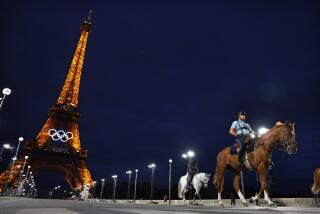Parisians Find Their Way About in a Smog
- Share via
PARIS — With the skies over the City of Light blurred by an eye-smarting pall of le Smog, French authorities for the first time ordered half of Parisian motorists to leave their cars home Wednesday and get to work and back some other way.
And to the surprise of many, the people of Paris--ferociously individualistic and devoted to their automobiles--mostly complied.
Socialist Prime Minister Lionel Jospin drove to the weekly meeting of the Cabinet in a two-door, electric-powered Peugeot. Many other habitual car commuters took the Paris subway, the regional rapid-rail service and buses, which were free for the day.
“What’s certain is that people are playing the game, that they are courteous, patient,” said Dominique Voynet, the environment and national development minister who imposed the restrictions.
On Tuesday, as the Eiffel Tower became shrouded in a light-brown noxious haze, a “Level 3” air pollution alert was declared in France’s capital.
Trapped under a dome of warm air, the concentration of nitrogen dioxide, a gas largely the product of motor vehicle exhaust, reached 442 micrograms per cubic meter of air, a level not seen here since Nov. 8, 1995, and one that French authorities deem harmful to health.
Outdoor physical education classes were suspended for children in the city’s 800 public schools, and a fossil-fuel-fired power plant in Vitry near Paris shut down.
A similar pollution level in Los Angeles, if sustained for 24 hours, would be close to a Stage 2 episode, in which people are urged to stay indoors.
Voynet, the first member of the Greens party ever to be environmental minister, has been roundly criticized for reacting slowly to air pollution problems in several French cities. This week, she ordered the first use of a 1996 law authorizing an alternate driving plan if pollution levels become too high.
On Wednesday, the minister announced, only cars with an odd registration number on the license plate could take to the streets of Paris and 22 surrounding suburbs. If the alert had continued through today, it would have been the turn of even-numbered cars, and so on.
But air pollution levels dropped to Level 1 by midday Wednesday, and authorities said all automobiles could return to the roads today.
It was uncertain how motorists would react to the restrictions. Every day, 3 million cars, trucks and buses enter or leave Paris, and at any given time 120,000 vehicles are on its 930-mile labyrinth of streets and boulevards.
“A Frenchman’s right to drive his car, even for an errand two blocks away, has acquired sacrosanct entitlement status,” the Paris-based International Herald Tribune observed tartly during the smoggy days of August. “Like guns in the United States, cars symbolize personal freedom in France.”
A thousand police officers were sent onto the streets Wednesday morning to check license plate numbers and to give violators a leaflet explaining the reason behind the law, rather than levy the $150 fine.
Still, many Parisians dutifully used public transportation.
“It’s obligatory and it’s good,” said accountant Roby Benjamin, 49, who left his car at home and was taking the Metro for the first time in three years.
Alain Plante, 53, a real estate agent with an even-numbered plate, left his car in a parking garage.
“It’s a good measure, but people need to be warned more in advance,” he said. “When they announce it, it should be for an entire week so people can organize their transportation and appointments.”
There was a host of exceptions to the odd-even rule, including ambulances; trucks delivering food or newspapers; hearses; cars carrying three or more persons; and salespeople. By one estimate, the exceptions totaled up to one-third of all vehicles.
Alain Camelin, 54, an electrician, was one of those exempt.
“They should do this every day,” he said, laughing. “It’s been a lot easier for me to get around town.”
By evening rush hour, the Ministry of Transportation estimated that traffic was down 21% compared to the previous Wednesday.
Police Prefect Philippe Massoni hailed Parisians for their “public-spirited reaction.” Many downtown arteries, like the Boulevard Magenta and the Place de la Republique in eastern Paris, looked as empty as during the August holidays.
With the number of motor vehicles in the French capital rising by about 3% annually, some critics said the odd-even rule is not a long-term solution.
Noel Mamere, an ecologist and lawmaker, said the real blame for dirty air lies with French automobile builders--Renault, Peugeot and Citroen--half of whose cars are now diesel-powered, producing more pollution than conventional engines. Corinne Lepage, Voynet’s predecessor, said if only environmentally friendly cars were allowed, traffic would be cut by two-thirds.
“This is really stupid,” groused 41-year-old Regis Moyson, who had to take a train and the Metro to work Wednesday. “I adapted for today. But they would do better to attack the basic problems, like developing less polluting cars and trucks.”
Martine Boissay, an engineer at Airparif, the agency that monitors air quality in Paris and environs, said the toxic substance responsible for the latest alert, nitrogen dioxide, can cause irritation of the lungs and mucous glands and provoke asthma attacks and cardiovascular problems in some people.
More to Read
Sign up for Essential California
The most important California stories and recommendations in your inbox every morning.
You may occasionally receive promotional content from the Los Angeles Times.













